PREVIOUS
The Election commission of India and Elections History - Part 5
May 10 , 2024
11 days
212
0
(இதன் தமிழ் வடிவத்திற்கு இங்கே சொடுக்கவும்)
History of Indian Parliament Elections (Lok Sabha)
- The Indian parliament follows a bicameral system.
- It has two houses, namely the Rajya Sabha (Upper House) & the Loksabha (Lower House).
- The party (or a coalition) that gets a majority in the Loksabha gets to form the central government.
- The term of office is for a maximum period of 5 years or until such time the party (or a coalition) enjoys a majority in the Loksabha, whichever is earlier.
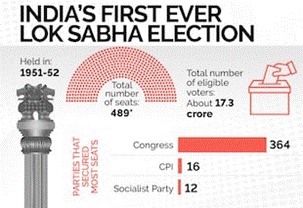
1st Lok Sabha — 1952/1957
- Total seats: 489
- It was comprising 68 voting phases (25 October 1951 to 21 February 1952), the lengthiest one till now.
- All Indian citizens over 21 were eligible to vote.
- While most voting occurred in early 1952, Himachal Pradesh cast its votes in 1951 to avoid weather-related hindrances.
- The first ballots were cast in the tehsils of Chini and Pangi in Himachal Pradesh.
- In the inaugural election, Congress, led by Nehru, won 364 seats, solidifying its dominance.
- The CPI, emerging as the principal opposition party, secured 16 seats, while the Socialist Party won 12.
- Ganesh Vasudev Mavalankar, famously known as 'Dadasaheb’, served as the first Speaker.
- Parliament’s enactment of the Representation of the People Act in April 1950 set the stage for the meticulous orchestration of parliamentary and state legislature elections.
- Across 401 constituencies spanning 25 states, the 489 Lok Sabha seats were strategically allocated.
- From the adoption of the first-past-the-post system in 314 constituencies to the unique representation of 86 constituencies electing two members, one from the general populace and one from Scheduled Castes or Scheduled Tribes.
- Each candidate assigned a distinct coloured ballot box at polling booths, featuring their name and symbol.
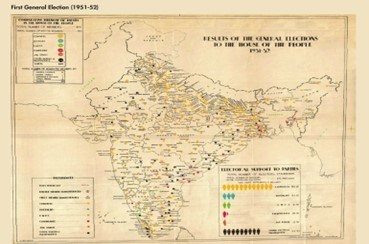
2nd Lok Sabha — 1957/1962
- Total seats: 505
- Under Nehru's leadership, Congress secured 371 seats in the second election, maintaining its stronghold.
- The Communist Party of India secured 27 seats, while the Praja Socialist Party won 19.
- This period also saw the implementation of the States Reorganisation Act of 1956.
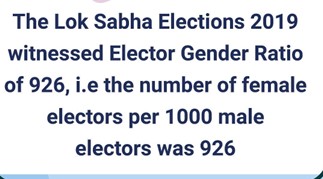
3rd Lok Sabha — 1962/1967
- Total seats: 508
- Despite internal dissent and challenges such as the war with China and Pakistan, the INC, led by Nehru, maintained its majority, winning 44.72% of the votes.
- Nehru served as the Prime Minister from August 15, 1947 till his death in May 27, 1964.
- There were two acting Prime Ministers during this time.
- It was Gulzarilal Nanda, who served twice, first from May 27 to June 9, 1964, and then from January 11 to January 24, 1966.
- Mr. Shastri held office from June 9, 1964, to January 11, 1966.
- Indira Gandhi succeeded Shastri as Prime Minister after Shastri’s death in 1966.
- This period also marked the introduction of indelible ink in the voting process.
4th Lok Sabha — 1967/1970
- Total seats: 523
- Indira Gandhi rose as a notable figure, becoming India's sole female Prime Minister to this day.
- Despite economic challenges, the INC secured a majority with 283 seats.
- However, internal conflicts led to the emergence of coalition governments.
- The Swatantra Party and Bharatiya Jana Sangh secured 44 and 35 seats, respectively.
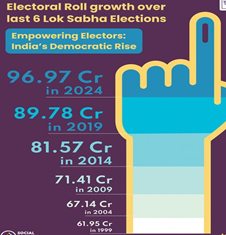
5th Lok Sabha — 1971/1977
- Total seats: 521
- Indira Gandhi's leadership during the Bangladesh war boosted her popularity, leading Congress to win a vast majority with 352 seats.
- However, the period following the emergency declaration in 1975 saw criticism of the Congress-led government for its authoritarian tendencies.
- The Communist Party of India (Marxist) came second with 25 seats, followed by the Communist Party of India and Dravida Munnetra Kazhagam (DMK) with 23 seats each.
- In this election around 48% of the voters were women, with the highest percentage of female voters recorded in Sriperumbudur, Tamil Nadu.
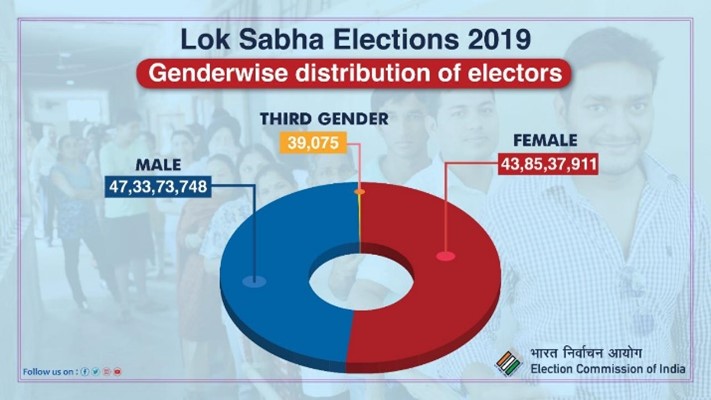
6th Lok Sabha — 1977/1980
- Total seats: 544
- The Janata Party's Morarji Desai became India's first non-Congress Prime Minister at the age of 81.
- He is the oldest person to hold the office of prime minister, at the age of 81, in the history of Indian politics
- In 1977, the Congress party faced a significant shift as it didn't secure a majority for the first time in Indian history during the General Election.
- Bharatiya Lok Dal (BLD) won the highest number of seats 295, followed by the INC 154 and CPM 22.
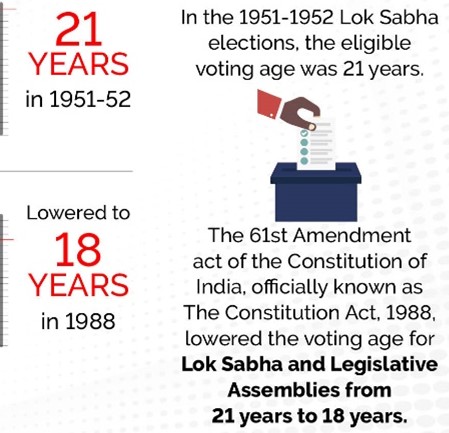
7th Lok Sabha — 1980/1984
- Total seats: 531
- In January 1980, the Indian National Congress achieved a swift victory, securing 353 seats in a four-day election period.
- The Janata Party (S) and the Communist Party of India (Marxist) won 41 and 37 seats respectively.
- The government faced tough times with problems like joblessness, worker strikes, and rising unrest in Punjab.
- The separatist movement in Punjab, led by the Akalis, demanded autonomy and territorial concessions.
- Despite talks, Indira Gandhi sent the army for Operation Blue Star to deal with the militants.
- Unfortunately, this led to her assassination on October 31, 1984, by her Sikh bodyguards.
8th Lok Sabha — 1984/1989
- Total seats: 516
- Rajiv Gandhi revived the Congress party, while N.T. Rama Rao reshaped politics in Andhra Pradesh.
- During this time, there was tension between communities, riots against Sikhs, and the Bofors scandal.
- This was when the Bharatiya Janata Party (BJP) entered politics for the first time, and the Telugu Desam Party (TDP) gained huge support under N.T. Rama Rao's leadership.
- In terms of seats won, the Congress party secured a record 414, followed by TDP with 30 and CPM with 22 seats.
- The 1984 elections were the last in which a single party won a majority of seats until 2014.
- And it was the only time to date in which a party won more than 400 seats.
- The BJP won two seats, one in Gujarat and the other in Andhra Pradesh (which is now in Telangana).
9th Lok Sabha — 1989/1991
- Total seats: 531
- The National Front coalition formed the government for the first time without a majority party in the Lower House.
- V.P. Singh of Janata Dal was then sworn in as the Prime Minister.
- During this time, unrest was stirred throughout the country due to the Mandal and Mandir politics, with protests against caste-based reservation and the Ram Janmabhoomi movement.
- Congress faced a severe defeat, winning less than half of the total seats they had won in the 1984 elections.
- Janata Dal secured 143 seats, while the Bharatiya Janata Party followed.
- The BJP gained the most, increasing their MPs from two to 85.
10th Lok Sabha — 1991/1996
- Total seats: 508
- In the 1990s, India saw significant changes.
- Narasimha Rao's economic policies liberalized the country's economy.
- The demolition of the Babri Masjid and the Mandal Commission report triggered violent divisions.
- Congress won 232 seats, BJP won 120, and Janata Dal won 59 in the 1991 General Elections.
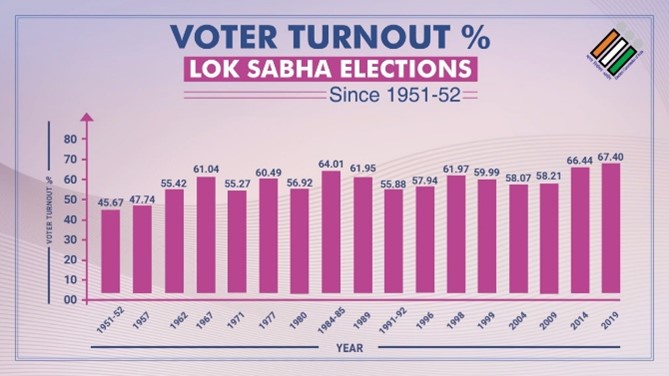
11th Lok Sabha — 1996/1998
- Total seats: 545
- In the 1996 General Elections, caste and regional politics became more prominent as people lost faith in the Congress government.
- The United Front government led by Janata Dal leaders was bogged down by corruption scandals and coalition instability.
- The Bharatiya Janata Party (BJP) became the largest party with 161 seats, followed by Congress with 140 seats and Janata Dal with 46 seats.
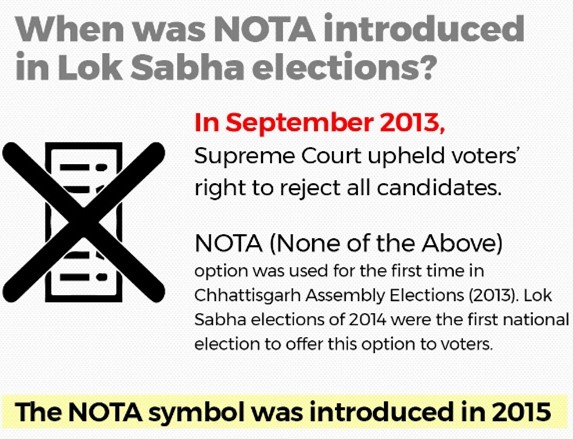
12th Lok Sabha — 1998/1999
- Total seats: 545
- The BJP won 182 seats, forming the government under Atal Bihari Vajpayee's leadership.
- The Indian National Congress followed with 141 seats, and the Communist Party of India (Marxist) with 32 seats.
- Vajpayee served as Prime Minister for 13 months.
13th Lok Sabha — 1999/2004
- Total seats: 545
- The BJP secured 182 seats in the 1999 elections, becoming the ruling party.
- The Indian National Congress won 114 seats, and the Communist Party of India (Marxist) won 33 seats.
- The government initiated significant infrastructure projects like the Golden Quadrilateral and Pradhan Mantri Gram Sadak Yojana.
- The elections also witnessed the piloting of electronic voting machines (EVMs) along with the traditional ballot papers.
- POTA legislation was enacted after the 2001 Parliament attack.
14th Lok Sabha — 2004/2009
- Total seats: 545
- The government led by Manmohan Singh achieved economic growth and passed important legislation such as the Right to Information Act and National Rural Employment Guarantee Scheme.
- In this election, Electronic Voting Machines (EVMs) were introduced for the first time.
- The Election Commission distributed 10 lakh EVMs throughout the country.
- The Congress party emerged as the single largest party with 145 seats, while the BJP came in second with 138 seats.
15th Lok Sabha — 2009/2014
- Total seats: 545
- The Congress-led UPA retained power, passed the Right to Education Act, and reorganization of Andhra Pradesh.
- Meira Kumar was appointed the first woman Speaker of Lok Sabha.
- She was the daughter of freedom fighter and former Deputy Prime Minister Jagjivan Ram.
16th Lok Sabha — 2014/2019
- Total seats: 545
- BJP won with the promise of 'acche din,' challenging the stasis and corruption of the Congress.
- Policies like GST, demonetization, 'Digital India,' and 'Swachh Bharat Abhiyan' were introduced during this tenure.
- The option of NOTA (None of the Above) was presented for the first time.
- It is allowing voters to express their dissatisfaction with the available candidates.
- BJP secured a significant victory with 282 seats, while Congress won 37 seats.
- Sumitra Mahajan was elected as the Speaker, overseeing the proceedings of the House during this period.
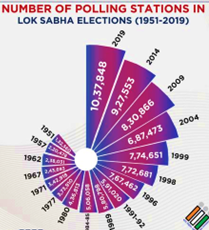
17th Lok Sabha — 2019/2024
- Total seats: 545
- The BJP government led by Narendra Modi further consolidated power after winning 350 seats in the largest-ever election held in the world.
- The elections were conducted in 543 constituencies in seven phases between April 11 and May 23.
- The period was marked by various significant events and issues, including concerns over national security, the COVID-19 pandemic, farmers' unrest, communal clashes, protests against the Citizenship Amendment Act (CAA), and the abrogation of Article 370 in Jammu and Kashmir.
- Notably, EVMs were 100% backed by a "voter-verifiable Paper Audit Trail" (VVPAT) for the first time, ensuring greater transparency in the electoral process.
- The 18th general election, which is being held in seven phases, will begin on April 19 and end on June 1, 2024.
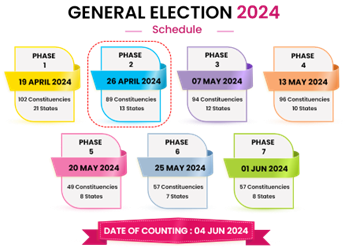
-------------------------------------
Leave a Reply
Your Comment is awaiting moderation.


